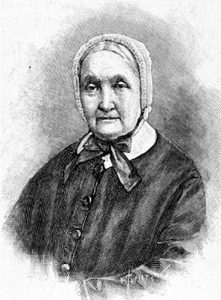La création en 1841
The community of the Deaconesses of Reuilly was created in 1841, and brought together women consecrated to God’s service, whose activity consisted in ‘relieving the miseries of the body and the soul, especially for the sick, the children and the poor’. To join meant wearing clothes similar to that of ordinary women: ‘to do acts of charity wearing the same clothes as common women and the same hat as servants. Thus these women would be considered as ordinary women fulfilling the true mission of womankind.’ (Letter from pastor A. Vermeil to Caroline Malvesin, 21 April 1841).
The clothing then consisted in ‘a simple black dress in the style of the day, long, with a full skirt and a front-buttoned, close-fitting blouse ; to which a headscarf, a hooded-cape or an apron were added, showing their dedication to work, plus a cap embellished with a veil’, but the headdress was soon considered too ‘monastic’ and too similar to that of Catholic nuns. After animated discussions within the community, a minutely-pleated bonnet completely covering the head and held with a ribbon and a black satin knot, as was worn by Sister Caroline Malvoisin, the first Reverend Mother.
During WWI the bonnet was too difficult to maintain and was replaced by a short veil similar to that of nurses.
After 1945
After WWII, the changes in the Catholic Church brought by Council Vatican II, and the social upheaval of the sixties ‘secularisation in our societies reached a no-return point’. Conversely, Protestant communities, as opposed to Catholic female congregations, and especially the deaconesses of Reuilly chose to make their religious involvement more visible, and their garment became a symbol and sign of that choice.
The dress was no longer black but a striking deep blue, long and with a scapular – a sort of monastery-related chasuble – taken off to put on an apron for service activities.
Their head-dress consists of a white mid-length veil, and they can choose to wear either shoes or sandals. On their garment they wear a rather large Huguenot cross – about four centimeters in diameter – engraved with the date of their consecration.
This very ‘religious’ habit, is the only exemple in French Protestantism, with that of the Deaconesses of Alsace and the Sisters of Pomeyrol, of the refusal of the clothing anonymity desired by the Churches of the Reformation. For the deaconesses of Reuilly it it is a sign of a spiritual evolution in which the contemplative life plays a larger part, and as the ‘Rule’ of the community states ‘this garment means that you are a member and (…) it acts as a silent word which we accept or refuse, but is there’.
The first address of the community was at 95 rue de Reuilly in the twelfth arrondissement of Paris – nowadays the mother house is in Versailles. At 95 rue de Reuilly an institute of Nursing Training as well as a resdence for young women workers can be found.




